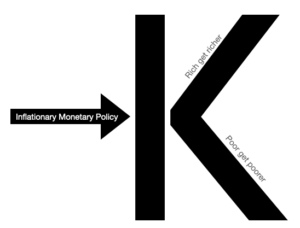
While the measurement of inflation varies wildly depending on which economist you talk to, here we will examine the official figures published by the Bureau of Labor Statistics (BLS): CPI or Consumer Price Index. The purpose of publishing CPI is to measure inflation and/or deflation, the decreased or increased buying power of the U.S. dollar. Awareness of inflation is essentially an awareness of how much our central banking system, the Federal Reserve, is printing or destroying money through “monetary policy.” This side of economics can get confusing, but it doesn’t have to be. This account will be an understandable explanation intended for accountants and laymen alike.
CPI is not calculated the same today as in the 70s & 80s
While remarkably high inflation is a key part of our memory of the 70s and 80s, if today’s CPI calculation methods were applied to the 70s & 80s, the CPI figures would be revised to show very low inflation – probably under 6%. Why? Two important concepts have altered today’s CPI calculation method, and this post will examine one of the two.
Hedonics Adjustment
Hedonics means “relating to usefulness” or more literally “relating to pleasure.” Firstly, let us understand that CPI is calculated using a basket of goods approach. This means that BLS figures out the most common goods that American consumers purchase, puts them into a virtual basket, and assesses how much more or less that basket costs each year. That’s it.
Over time, politicians have argued that such a simple approach is flawed, and some of these arguments have resulted in altering the BLS policy of how to calculate and report CPI. One such alteration is for “hedonics.”
This argument says that one must look at the increased usefulness of goods over time and expect increased usefulness to bring increased price with it. This is basically relating to technological advances. For example, if a computer is in the basket of goods, BLS is tasked with how to measure the price of a computer. Ten years ago, a standard home computer would come with a 200MB hard drive. Today, a standard home computer would more likely to come with a 200 GB hard drive offering 100 times more data storage space. So the hedonics adjustment concept says that today’s computer should be much higher in price. Because it is actually the same price or lower, BLS adjusts the price of this computer to pretend the price has gone way down. This actually will counteract other items in the basket of goods that went up in price.
Let’s take a very simple look at this adjustment concept via a fictional example. Let’s say we are tracking a basket of goods, and in this basket there is only a home computer and gasoline, and we normally spend an equal amount of money on both. Let’s say $500 on each, for a total of $1000. Assume that since last year, gasoline has gone up 50% in price (up to $750), and the usefulness of the computer has doubled. The hedonics adjustment would adjust the computer price to pretend it’s half of last year’s price ($250) because of its “doubled usefulness.” So this particular inflation calculation would output 0% inflation. Meanwhile in realityland where us citizens work, play, and balance our checkbooks, we are paying $1250 where we used to pay $1000. Or more realistically, buying computers less often and traveling less. This hedonics adjustment is used for a variety of electronic equipment. The actual adjustment is much more complicated, but it is based on the same idea.
Problem 1 – Other causes of increased usefulness and decreased prices
Decreasing Prices – Part of the progress of technological evolution is that new devices grow in popularity, more people buy them, and this introduces the concept of economies of scale. This means that increasing the manufacturing quantity of a device will decrease the per unit cost of production. This is because there are fixed costs (like research & development or machine tooling) that don’t increase with increased production. For this reason, as a device grows in production and sales, its price will drop because it can and will in open market competition.
Increased usefulness – This isn’t rocket science. We humans are inventing and innovating. This shouldn’t bring prices up. Competition brings prices down. The price of an item is ultimately largely tied to the price it costs to produce it. When production costs come down, a competitor will come along and offer a reduced price. Innovation increases usefulness, but it also increases efficiency. The ultimate effect of innovation is likely to be more of a downward pressure on prices than an upward pressure.
Ultimately, there is no agreement among economists that technological advances in electronic equipment is a sign of monetary deflation, yet this is exactly the shoddy concept that is currently used in CPI calculation.
Problem 2 – The hedonics adjustment doesn’t go both ways
You know the saying “they don’t make ’em like they used to.” Although this isn’t always the case, there are certainly products emerging of a cheaper quality and a lower usefulness. Many of today’s products (especially thanks to Wal-Mart) are of cheaper quality than yesterday’s products. As more and more products are made in China rather than “Made in U.S.A.” we often find ourselves with cheaper products that need replacing more often – i.e. decreased usefulness. I don’t believe this phenomenom is accounted for in BLS’s hedonics adjustment.
The big picture
BLS is basically taking the position that our original, simple approach to CPI only works in a society where there is no innovation. We are quite innovative, and technological advances in our society are actually substantial and rapid. To adjust for this, every year BLS pretends that electronic equipment costs less than it actually does. The bottom line is that CPI is no longer a figure that represents inflation in the real world. It instead represents inflation in an imaginary world where you can go to the store, select a computer that costs $1000, pay $1000 to buy it, and somehow only have $500 debited from your pocket.


